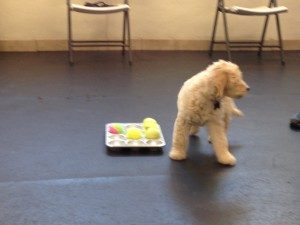As always we open with:
ATTENTION
- Attention exercises while on mats
- Attention Exercises with distraction.
- Instructors greet students who click and treat their dogs for appropriate posture and interactions.
- As dogs succeed we raise the difficulty level little bit by little bit.
- Handlers deliver 10 treats in 10 seconds to their dogs, and repeat this exercise 5 times during class to continue to build the dogs’ focus. Dogs never know when such an awesome reward will be coming, and so keep tuned in, just in case.
INFORMATION
By Stanley Coren and Sarah Hodgson from Understanding Your Dog For Dummies:
Dogs’ sense of smell is their primary sense, even more than vision or hearing. Whereas a human has 5 million scent receptors, a German Shepherd has 225 million scent receptors.
“A dog’s brain is also specialized for identifying scents. The percentage of the dog’s brain that is devoted to analyzing smells is actually 40 times larger than that of a human! It’s been estimated that dogs can identify smells somewhere between 1,000 to 10,000 times better than nasally challenged humans can.”
CONFIDENCE
In order to exercise our dogs’ sense of smell, and tire and calm their active brains in a good way, we recommend using food toys for part or all of their meals. A simple ball filled with kibble, a Kong stuffed with moist food, or tennis balls hiding treats in a muffin can all serve to let our dogs enjoy their natural scenting skill. It also enhances confidence because dogs are good at this!
BEHAVIOR
Recalls: Come When Called
We begin to train recalls first by building attention:
- While next to your dog, call her name.
- Click/treat for attention.
- Don’t ask for any other behavior than attention.
If your dog doesn’t look at you the first time you call her name, make an interesting noise such as kissy noises, trills, chirping, etc.
Don’t use potentially aversive noises or actions such as snapping fingers, clapping hands, etc., until you have determined (when not practicing recalls) that these are happy noises for your dog.
- Gradually increase your distance from your dog when you call her name.
If you have a training partner, play the “Name Game”, where each person calls in turn, and as the dog races toward him he clicks and treats and makes a party.
If you don’t have a training partner, toss a lower value treat away from you, and let your dog eat it. Just as she finishes the treat call her name, click as she speeds toward you, and reward with a high-value treat when she gets there.
Don’t punish for getting it wrong. Just make yourself more dog-alluring!
- Better treats
- Running away from your dog
- “Party voice”
- Squeaky toys
Never ever call your dog to do something that she finds even the tiniest bit unpleasant such as
- Nail trims
- Baths
- Ending play
- Being left while you go out
If you need to do something your dog doesn’t love, go and get her, rather than ruining your recall.
Things to Bring
- Your Pup!
- Well-behaved children and spouses 8 or older.
- A flat collar, harness, or martingale collar.
- Lots of pea-sized soft treats in at least two different flavors. 200 tiny pieces are not too many. Some suggestions: Hot dogs, String cheese, Meatballs, Chicken or Tuna, Baby food (in a camping tube), Vienna sausages, Liverwurst, Thin-sliced Beef.
- A fanny pack, carpenter’s apron, or treat pouch to hold your 200 tiny pieces.
- A 6-foot leash.
- A mat, bathmat, towel, or blanket for your puppy or dog to rest on.
- Water and a bowl for when your pup gets thirsty.
Do's and Don'ts
- Do let us know if your pup has any food allergies so that we can be careful not to give him a troublesome treat.
- Don’t bring prong, choke, shock, or citronella collars.
- Don’t bring Flexi or other retractable leashes.
- Puppies and dogs should not meet while on leash in class, or while coming and going. There will be opportunities for off-leash play for compatible puppies, and good neighbor exercises for older pups and dogs.
- Don’t feed a heavy meal before coming to class. In fact, your in-class treats can serve as your dog’s breakfast on class day!
- If your puppy or dog is ill, please leave him at home to recuperate, but feel free to come to class without him so that you can learn what’s on the agenda for that day.
Puppy Kindergarten
Puppy Topics
Puppy eBooks
- Ian Dunbar’s Before You Get Your Puppy
- Ian Dunbar’s After You Get Your Puppy
Training Video
Homework 1
- Play with your puppy.
- Catch your pup in the act of doing five different things you like. Click and Treat. Repeat.
Homework 2
- Have your dog “Wait” for you to put her food bowl down for each meal.
- Couple handling with treats a few times a day.
Homework 3
- Practice Loose Leash Walking in a new location. Remember that three good steps are so much better than thirty steps on a tight leash.
- Look for features on your walks that can serve as parts of an Out-and-About Confidence Course.
Homework 4
- Surprise your dog with ten treats in ten seconds at least three times a day.
- Practice the Name Game three times a day.
Homework 5
- Discover a new opportunity to help your dog choose an appropriate behavior.
- Write down the first five steps that you would train.


